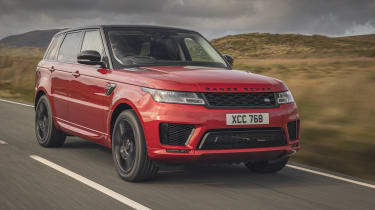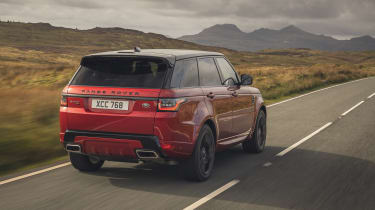Range Rover Sport review
A strong combination of full-size Range Rover elements in a more attainable package, but objectively it’s no class-leader
The Range Rover Sport is Land Rover’s direct rival in size, cost and capability to popular premium SUVs like the BMW X5 and Mercedes GLE. This generation of the car has been with us since 2014, but has been continually updated inside and out to keep it in touch with fresher rivals.
The Range Rover Sport was developed with a clear brief to drive better on the road than its full-sized sibling, the Range Rover, without abandoning the off-road capability or the regal on-road demeanor that define the Range Rover brand.
> Aston Martin DBX review - the first performance SUV to deliver on its promise
As part of its 2021 model year update, the Range Rover Sport has received a new in-line six-cylinder diesel engine, replacing the previous V6 and V8 diesels which have long made up the vast majority of European sales. As well as updating the powertrain offering in the UK, it also future-proofs the model for the last few years of its lifespan before the all-new Range Rover Sport appears some time in 2022.
The rest of the powertrain range is made up of turbocharged four- and six-cylinder petrols, a plug-in hybrid and a supercharged V8. So, with unmatched off-roading ability plus that Range Rover image underpinning its appeal is the Sport still a contender?
Range Rover Sport: in detail
- Engine, gearbox and technical highlights > New Ingenium units make up a majority of the engine range, the old supercharged V8 tops the range
- Performance and 0-60 time > Performance comes despite the car’s substantial mass, itself a bi-product of the trademark off-road capability
- Ride and handling > Feels its weight, but is more controlled than the big Range Rover on-road
- MPG and running costs > Plug-in hybrid models help clean up the RRS's image on paper, but no version is frugal
- Interior and tech > Once cutting edge, the interior tech is a generation behind. Feel and ambiance is still lovely though
- Design > Feeling a little tired in 2021, but it retains its traditional appeal
Prices, specs and rivals
The Range Rover Sport starts at over £65,000 for P300 four-cylinder petrol in base HSE trim, with the D300 in-line six diesel starting around the £68,000 mark. The P400 in-line six petrol is next up at £72,000, and the P400e plug-in hybrid is just £1720 more.
More reviews
In-depth reviews
- Range Rover 2025 review – there’s no need to go electric
- Range Rover review (L405, 2012-2021) – verdict, specs and rivals
Long term tests
Reviews
All of these ‘base’ engines can be specified all the way up to Autobiography Dynamic trim, which represents a £18,000 price variation from the most basic spec to the flagship. Standard equipment is strong across all models though, highlighted by Matrix LED headlights, leather trim, Land Rover’s Duo Touch Pro digital interface and 20-inch wheels. HSE Silver, HSE Dynamic and HSE Black models then populate the middle ground, adding larger wheels, upgraded interior trim, bigger wheels and the aesthetic variations like black or silver trim packs depending on the model.
For access to the high-powered D350, you’ll have to plump for the HST trim level, which lifts the price to £86,000, while the petrol V8-powered P525 is only available in fully-loaded Autobiography Dynamic trim at £92,000. Only the performance-topping SVR model is available with JLR’s full-fat 567bhp V8, which costs from just under £102,000.
Autobiography Dynamic models build on the HSE trim level with wheels that jump up yet one more inch in size. The standard leather is swapped to the soft semi-aniline finish you’ll find in the full-fat Range Rover, there’s suede-cloth headlining, an updated stereo and various parking aids beyond the standard reversing camera. The HST trim adds some dubious carbonfibre trim elements, while the SVR comes with its own performance-oriented seats, finishes and body styling.
Model-for-model, the Range Rover Sport has always been priced above its BMW, Porsche and Mercedes-Benz rivals, with Porsche and BMW both offering entry-level petrol and diesel volume models that sit close to £60,000. Go for hybrid models and that gap does shrink, particularly with the Porsche. Meanwhile, at the upper end of the spectrum both BMW’s new X5 M and Porsche’s Cayenne Turbo now cost well into six-figures, with the BMW X5 M nudging £130,000 when fitted with the optional ‘Ultimate Package’.
> Read our review of the Porsche Cayenne here




